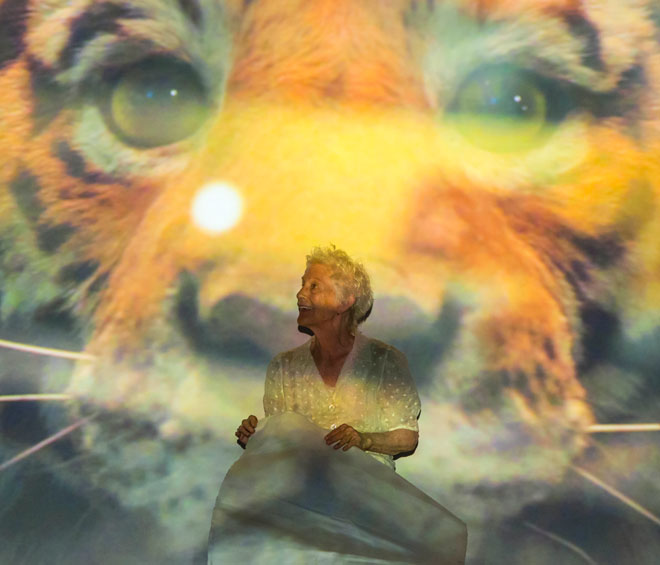
by MK PALOMAR
Studio International visited Tate Modern to speak to pioneering artist Joan Jonas, long revered and most often described as a performance artist. Jonas, however, (for reasons explained below) would prefer to be known as “an artist”. Her current exhibition at Tate Modern is astonishing in the rich visual slips and sleights of hand explored and displayed, and exhilarating and life-affirming in the breath of light, multilayered imagery and spaces given to the audience. Jonas’s work is a tapestry of filmic and spoken narratives, full of poems, songs, myths, animals and birds. Ever present in her works are masks, reflections, film recording, sound and drawing – there is always drawing.
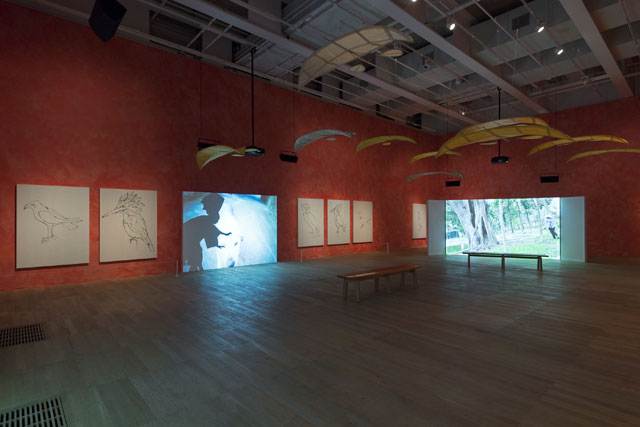
Joan Jonas, Tate Modern, installation view. © Tate Photograph: Seraphina Neville.
Alongside Jonas’s exhibition inside Tate, there have been live performances in the Turbine Hall. Invited to recreate her early outdoor works, Jonas (b1936, New York) also revised some performances, along the Thames embankment. She says: “The original piece was maybe around 40 minutes but this version was shorter. The performers were on both sides of the Thames, just at low tide – it was like a mirror image. I made it very short, about 12 minutes, and then we repeated it twice.”
Documentation of the Thames-side piece showed the performers dressed entirely in white, their footfall crunching the pebbles as they walked back and forth along the river’s banks.
“The performers were hitting blocks of wood together to make the (tapping) sound, and on the other side (approximately 1.5 miles across the river Thames), they were doing the same thing – they were talking back and forth to each other,” she explains.
Did the sound carry over to the water?
“Yes, it did, and they were also calling back and forth with megaphones.”
There are many instances in various and diverse cultures such as in Papua New Guinea, Greece and the Canary Islands, where people communicate across great distances, locating each other and creating sonic networks, resonating with the environment.1 These resonances tap (sonically and physically) into our most ancient and phenomenological experiences of being in place and space, and they are present in much of Jonas’s works, tapping awake our innate intuition.
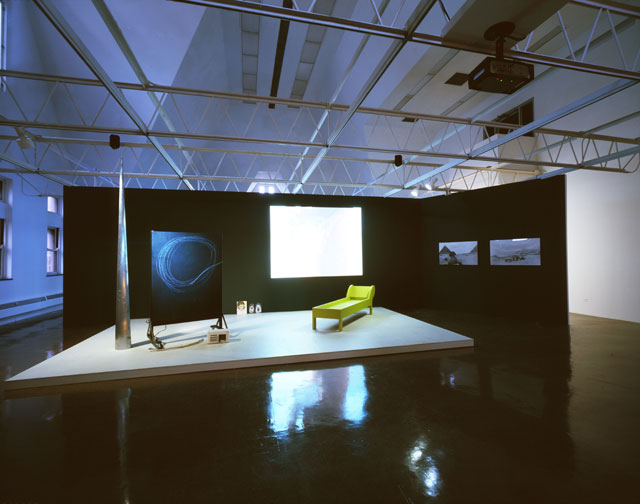
Joan Jonas. Lines in the Sand, 2002. Installation Video (Lines in the Sand 2002/2005. Colour, sound, 47:45 min), projection, blackboard, wooden structure, paint, video (Pillow Talk, 2002, colour, sound), monitor with performance video, green wooden couch, sand and relief box, plaster, photographs, paintings), dimensions variable. Museu d'Art Contemporani de Barcelona, 2007. Photograph: Juan Andres Pegoraro. © 2018 Joan Jonas : Artists Rights Society (ARS), New York : DACS, London.
MK Palomar: This year’s Tate Live Exhibition: Ten Days Six Nights celebrates your work and your influences. The text on the Tate website explains that, for the past five decades, you have been instrumental in shaping the art forms of performance video and installation. I would like to focus on one aspect of your work – drawing. For your 2004 exhibition Lines in the Sand, Stephen Foster, the then director of the John Hansard Gallery in Southampton, wrote: “Drawing runs through Jonas’s works over a long period.”2 Can you tell us what drawing means to you now, and has your relationship with it changed over the past 50 years?
Joan Jonas: Drawing is part of my language, and the way my relationship to it has changed is that, from the very beginning, for each work I found images, or I focused on images that were aspects of the content of that particular work. Also, I invented ways of drawing in relation to the action, the media and the scale of the space or the setting. For instance, in the early video pieces, I drew dogs again and again in different ways, so there were drawings of dogs made in live performance in relation to the vertical roll of the monitor – for instance, the top of the head would appear at the bottom of the paper, the bottom or nose would appear at the top and these works would be included in the installation with other dog drawings that were portraits or dog icons that I made outdoors or in my studio. I drew for the monitor. I have this phrase: “I draw for the monitor.” So I made drawings looking at the monitor and not at the paper.
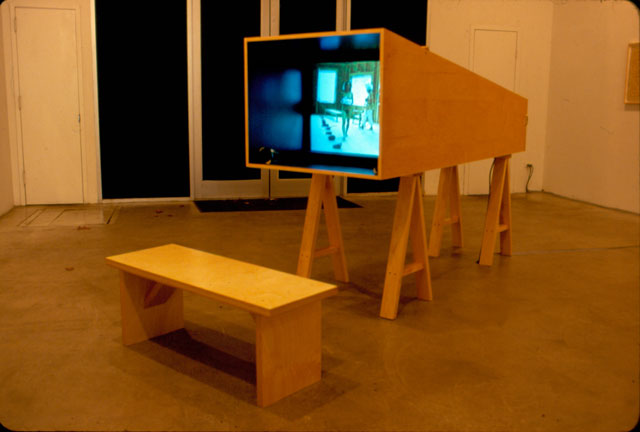
Joan Jonas. My New Theater III, In the Shadow a Shadow, 1999. Installation view: Pat Hearn Gallery, New York, NY, 1999. © 2018 Joan Jonas : Artists Rights Society (ARS), New York : DACS, London.
MKP: When you look at the monitor, who is it or what is it?
JJ: Well, I see myself – I watch the image of the paper on the screen as I trace a drawing for the camera that sends this to the monitor, so it’s an indirect way of relating to the paper that I’m drawing on. I worked with the closed circuit of camera-monitor-projector-subject. This might be in a performance. That’s one way. I also draw in my studio without intervention; drawing is one of my favourite activities, I could say. I copy things from books, I draw from nature and I make up drawings. In this show, you also see large-scale drawings – the scale of the drawings I make during a performance vary. For instance, for the Line in the Sand performance, using a three-foot-long stick with chalk attached, I made a large step pyramid drawing because of the subject matter (the epic poem Helen of Egypt by Hilda Doolittle) and then I made drawings of patterns of walking, two interlacing circles. Both involved movement of the body. I become interested in certain subjects and I draw them over and over again. In my most recent piece (Stream or River, Flight or Pattern), with the big red room with the drawings of birds, the birds are not drawn in performance, they are copied from a book about birds from Thailand. The book was a gift that was given to me. Certain subjects come into my focus. I’ve been filming birds and drawing them in a very simple way.
MKP: Why do you draw?
JJ: I’m a visual artist. I like to draw; it’s one of my languages. I studied art history and I went to art school, I studied drawing as a basic structure. I could say that choreography is drawing in space. To draw was one of the most important things for me.
MKP: Is it a way of connecting with yourself and the subject at the same time, because of the tactileness of it?
JJ: Yes, and also juxtaposing this tactile activity – touching the page with my hands – with this technology that I work with.
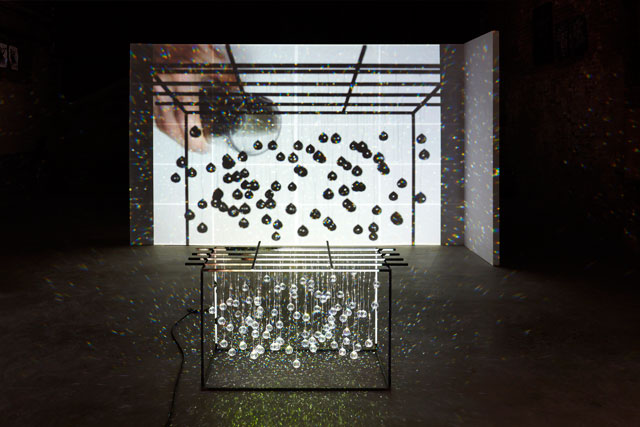
Joan Jonas. Reanimation Installation 2010, 2012, 2014. Private collection. Photograph: Thomas Müller. Courtesy the Artist and Gavin Brown's enterprise, New York: Rome. © 2018 Joan Jonas : Artists Rights Society (ARS), New York : DACS, London.
MKP: After your 2013 Tate Live performance Draw Without Looking, which was live streamed online, you spoke to the curator Catherine Wood about what you have just mentioned – not looking at your drawing when you draw, and instead watching the monitor recording/displaying you – and so there’s a sort of dislocation.
JJ: That’s one way I draw – but, for instance, I drew those birds that you see upstairs by looking at the paper and looking at the source, concentrating on the outer form. My fish drawings were all copied from another book, about fish. I also like to experiment with material. The fish drawings – some of them are in Reanimation (2010/2012/2013) – were all drawn very fast with ink on paper; it’s another way to draw. That was a challenge to make drawings with ink; maybe each drawing takes 30 seconds to make. So, it’s another way of approaching drawing. I’m interested in materials and methods, techniques, the brush, the pen, different tools, graphite, chalk – chalk is another tool.
MKP: Can I ask you about the gap between your thinking and your doing of drawing? You talked about not thinking when you drew the fish on the wall for Reanimation, and I wonder if that allows for a sort of slippage – a fluidity of some kind?
JJ: Yes. One of the reasons I like to draw in performance is because the results surprise me. I think often people draw without thinking logically: in your studio, you could do that. But, for me, if I’m performing I’m co-ordinating so many things – moving, behaving, performing – while I’m making a drawing. And there’s also a different way that drawing relates to your body. And so that interests me and that’s one of the reasons I’m interested in drawing in performance, because I’m not self-conscious about what the drawing is: I’m not going to think, is it good or bad? Sometimes, in the studio you’re wondering is this a good drawing? You know – I want to make a good drawing – in the performance, you would never really have time to think that. Of course, I do practise drawing. I don’t just draw without practising.
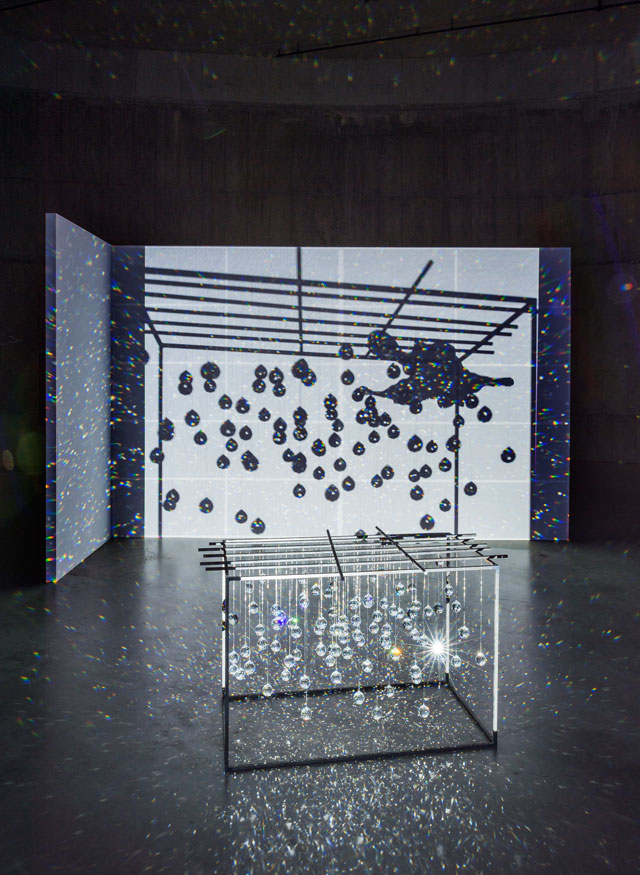
Joan Jonas, Tate Modern, installation view. © Tate Photograph: Seraphina Neville.
MKP: Going from what you said to Catherine Wood after you had done that live performance of Reanimation, is the process in any way a striving to connect with a sort of semi consciousness, or the transportation that children experience when they are lost in play?
JJ: Probably, although I don’t think of it as semi consciousness, but, of course, one of my ways to improvise and invent is to play. I think play is a very important activity for artists in general. I don’t do that in public really, although I have lately become freer.
MKP: Why do you say lately?
JJ: Because it took me a long time. I mean, now I work with the musician and composer Jason Moran. He’s a jazz musician and jazz musicians improvise, although they improvise on a theme. When I make a performance, I rehearse and set the movements, so if I do a series of performances several evenings in a row, they’re pretty much all the same, except for small variations. But jazz musicians can really riff, as they say. So, working with Jason, I’ve become more free. I’ve enjoyed collaborating with sound using bells and instruments. I’ve always done that, but [now] its different I’ve developed … and, also, I’ve never spontaneously talked in front of an audience until the last few years. We, did a joint performance, Working Together: A Lecture Demonstration, here at Tate Modern in 2015 – it’s on the website.3 We’ve done it several times. We were asked to do a performance in New York and the Institution (Columbia University) couldn’t afford it at the time, so I decided to do Working Together: A Lecture Demonstration, where we demonstrate and quote samples from the different works we’ve done together. And we talk in between. I wouldn’t have done that 10 years ago – but now I enjoy it. This also is the result of years of teaching and giving lectures.
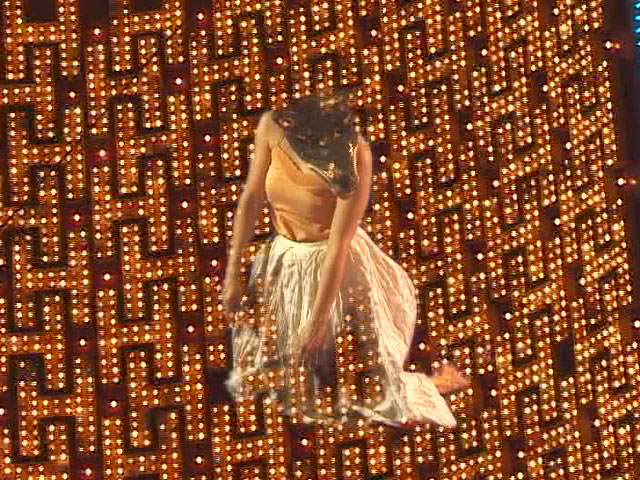
Joan Jonas. Wolf Lights, The Shape, the Scent, The Feel of Things, 2005. Video still © 2018 Joan Jonas : Artists Rights Society (ARS), New York : DACS, London.
MKP: Do you think this newly found ability to speak spontaneously is because you were working in collaboration – with Jason Moran. Was he there with you?
JJ: Yes, he was, so maybe. I think that it’s just been gradual. I’ve talked to other performers, and some are very shy people, and performing gives you a kind of mask and distance from the audience. Or from people, actually. You’re doing something rehearsed and it’s formulised. Over the years, I’ve gradually got over that initial shyness: it’s been a long process because I’ve never made theatre. People call me a performance artist, but I have to say I don’t like that term. Because I think I’m an artist. I tell you why, because, what does it mean when somebody says performance artist? I perform for the camera for most of my work, which a lot of artists do, or they have other people acting for the camera. So, I see “performance” referring to a live event. When I do a work for an audience, I call that a performance. I mean you could say I perform for the camera, and you could say that I’ve developed a language or structure over the years, it’s true. But I also make video art or video works – I hate the term video art – I also make autonomous video works, that have different considerations from live performance, and I make drawings and installations. So those are forms – I translate constantly from one form to another. That’s why performance is not really an adequate term for me. I’d like to be just … why can’t I be “an artist”? (laughs).
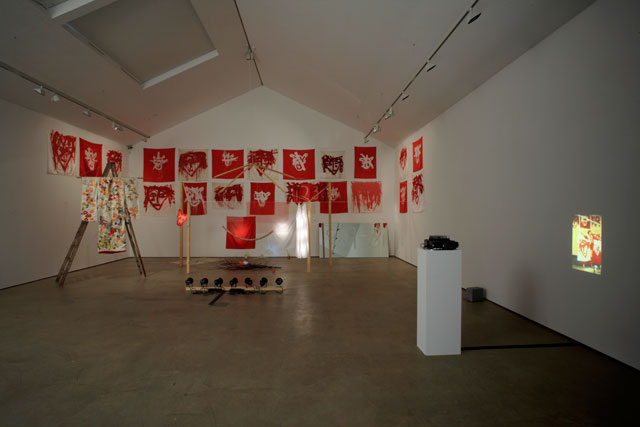
Joan Jonas. The Juniper Tree, 1976/1994. Installation - 24 works on silk, acrylic paint, wooden structure, string of 29 wooden balls, ladder, kimono, mirror, glass jars, 78 slides, box and other materials, overall display dimensions variable. Tate, purchased 2008. Wilkinson Gallery, London, 2008. Photograph courtesy Wilkinson Gallery, London. Photograph: Peter White. © 2018 Joan Jonas : Artists Rights Society (ARS), New York : DACS, London.
MKP: I think you are! At the beginning of your live performance Draw Without Looking 2013,4 you begin by reading a list of directives, among which are: “Imagine a floor plan, move among large shapes … Move as if at the bottom of the sea … great pressure … blindfolded …” These suggest you have an acute and direct physical experience of site and place, so I wonder how you navigate the translation from your physical experience into the technological world/film and or documentation? Is there a division between the physical and the technological?
JJ: Well, when I work with my camera, it’s an extension of my body – there’s not really a division. But, considering the camera’s viewpoint and the process of editing and the structure, the approach is different. One of my main concerns from the very beginning has been to work with spaces. I didn’t really do Reanimation for the Tate but I installed it there (in the East Tank at Tate Modern), and it really is affected by the space. In the very beginning, I worked with outdoor space, and also with the space of rooms, as well as the space of the monitor or the framed space of video or film. So my work relates to the space … it’s affected by the space. Although the white-cube gallery doesn’t have very much effect, one always has to arrange and take into consideration the quality of the space. I was interested in architecture and spent time looking at certain architecture, for instance Romanesque architecture, which I’ve always loved, so I’ve always been involved with considering space and walking into it.
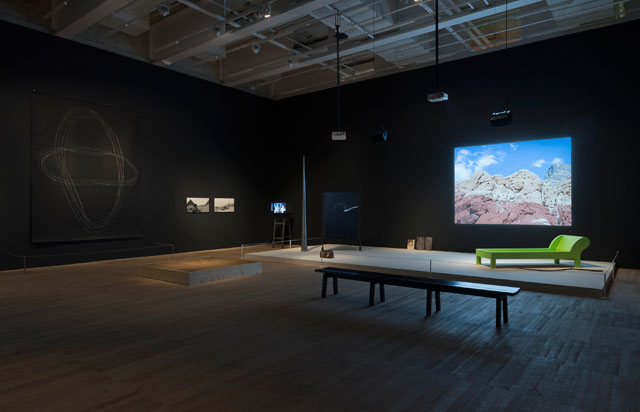
Joan Jonas, Tate Modern, installation view. © Tate Photograph: Seraphina Neville.
MKP: Your 1976 work I want to Live in the Country (And Other Romances) celebrates rural outside spaces and animals, and your Tate exhibition now includes various films that show rural spaces and different animals – as though you are leading your audience back into the natural world. Why are rural spaces and animals, in particular dogs, often present in your work?
JJ: When I grew up, I was very lucky to go in the summers to the country, to the mountains. So, I grew up looking at landscape, and I love it. As a child, I used to like to walk in the woods in New Hampshire, to look at the mountains, to walk in the fields, so that, when I considered myself an artist, I immediately started to work outdoors as well as indoors. I also go to Canada in the summer, so the landscape is a natural place for me in which to work, to move, to film, to record. It has become part of my language and I love the outdoors. I mean, it’s beautiful. It plays a large part in my work. Nature is not a good word; but the “outdoor space” and the qualities [of things there, for instance] the sound of the outdoors, I consider how sound is delayed, [and] distance, the idea of distance. And then animals … well, throughout our history, myth is referred to – and used to represent – certain ideas and characters. I really like James Joyce’s A Portrait of the Artist, where he uses the myth of Sisyphus in relation to a character. I did a lot of research into mythology, and ritual and animals play a large part in that, it’s the fairy-tale, the animal helper, the cat, the dog, the horse, they’re characters in fairy-tales and myths. And so, when I began to make work I had a dog, and I worked with what was around me, you know what was in my world, and the dog was there, and so I became obsessed with drawing that dog, so, since then, dogs and animals have been part of my world because they’re with us. My dogs were all natural performers. And then I felt this when I had a work in Venice [They Come to Us Without a Word at US Pavilion, the Venice Biennale, 2015). I began focusing on different kinds of animals, and creatures, not just dogs.

Joan Jonas, Tate Modern, installation view. © Tate Photograph: Seraphina Neville.
MKP: Your list of directives also mentions telepathy and magic shows. Tracey Warr in her text What a Performance Is, written for your Lines in the Sand exhibition catalogue, explained that you have seen your work as “… in between dance and sculpture … that your performance … repetitive drawing with a piece of chalk attached to a branch … gestures shamanism … and you have described yourself as an electronic sorceress.”5 Can you tell us a bit more about gesturing at shamanism and electronic sorcery?
JJ: I think that probably all artists, when they begin, do a certain amount of research and are interested in certain things. I was very interested in shamanism and the idea of the sorceress and how women are represented in history and the role they play in society as healers and sorcerers, and that has stuck with me. I no longer do that research, but it’s something that’s stuck with me and I think it’s important to lose yourself. Losing oneself in a performance relates to ritual. I studied the ritual of other cultures: I didn’t quote other cultures exactly but it influenced my work. So, I had to imagine myself as a kind of a character, enacting a contemporary ritual for my friends and that’s why I made that statement about the electronic sorceress. I wouldn’t say that now, but I said that then. I used to work only at night because of the absence of light in relation to the video that was electronic.
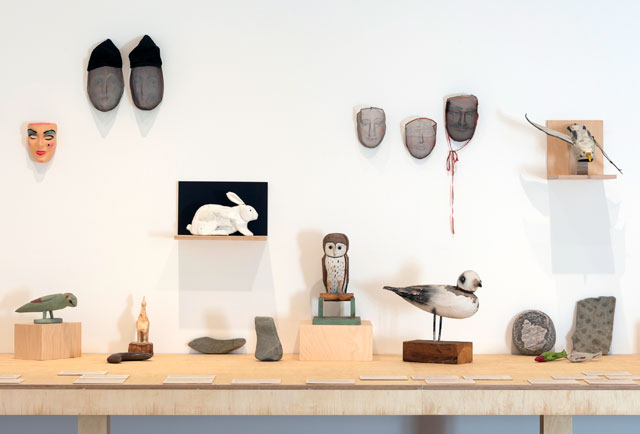
Joan Jonas, Tate Modern, installation view. © Tate Photograph: Seraphina Neville.
MKP: In your 2013 live performances, there appears to be a morphing of dimensions, when you interact with the projection – a sort of slippage of space and time – the heightening of the audience’s transportation by the sounds of ancient chanting, and when you perform, as you did for Tate online, you reached out to the watching world online, shifting to another kind of dimension and space. Where does this go next, this shifting and morphing? Live Skype collaboration?
JJ: Well, I could. The reason I did that piece for the Tate is because they proposed it. I work with technology, but I work with very simple technology. I’m very interested in making effects without technology, for instance with layering images and projections. If the situation arose, I think I would do a live Skype collaboration, but so far I haven’t done that. I very much liked that experience with Tate live. I liked the idea that I was connecting to a large invisible audience – that was quite wonderful, but I’ve never done that on my own.
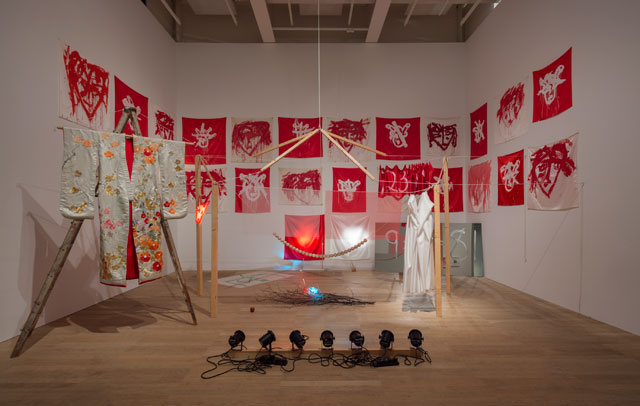
Joan Jonas, Tate Modern, installation view. © Tate Photograph: Seraphina Neville.
MKP: For that work, we the audience couldn’t see the technology behind the camera …
JJ: I composed a video projection in my loft in New York, which was projected in that room in the Tate, so I was simply moving in the space of projection. There were a few people behind the camera, one camera that was passing the image to YouTube, and no other technology in the room. All that paraphernalia was in the room next door. It was just me performing in that space. I should do something with it again maybe. What I liked about that was that it was illusionistic, so you appear and disappear – its looks as if you’re really embedded in the space.
MKP: A sort of conjuring? When you put paper over yourself and disappear into the projection and when you wear a mask and come forward …
JJ: Yes, I like very much that perception of the space being ambiguous, so the audience doesn’t know exactly where you are. It’s three-dimensional but it’s not, and, also, it’s mysterious and magical. I often went to magic shows as a child, and the idea of magic and sleight of hand had a big effect on me.
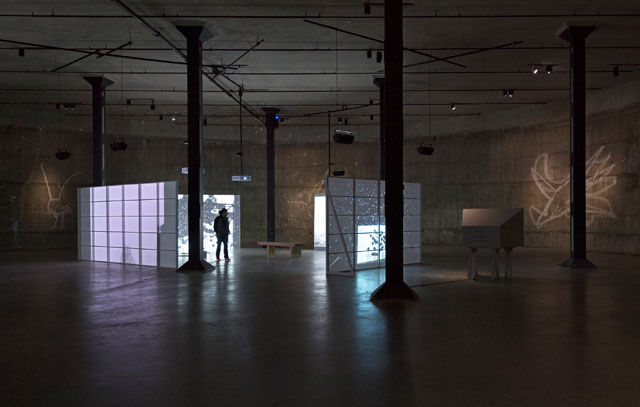
Joan Jonas, Tate Modern, installation view. © Tate Photograph: Seraphina Neville.
MKP: In your exhibition here now, one of your installations shows you walking through a bamboo forest, and then, for a minute, you appear to be behind the trees and then in front, and there’s a slip – a marvellous visual surprise.
JJ: Yes, we had a projection of a bamboo forest in Vietnam, and then we put some sticks in front and so that’s what gave the illusion.
MKP: The way you and your collaborators were moving while you performed through the space heightens that sense of illusion. When you introduced the Mirage performance last week, in which you performed live in front of film footage of yourself some years ago performing the same work (Mirage), there appeared to be some sort of time-travel in the process while you were performing. Did you remember what it was like to be your previous self?
JJ: Well, yes – my body was very different, although I wasn’t thinking psychically of who I was. I haven’t seen the video of that yet; I’m very interested in seeing what that looked like. It interests me, this juxtaposition of these two selves – of the same person – because you look on your past and think; how did I do that? And who was I then? And I think, when you get old, there’s this great distance between your young self and your old self. It’s a mystery in a way, a little bit, so I’m looking forward to seeing [the documentation of Mirage#3]. I noticed that I look very small, and I’m very big in the projections. That’s one of the reasons I wanted to do that piece, to perform that piece that way. I’ve never done that before
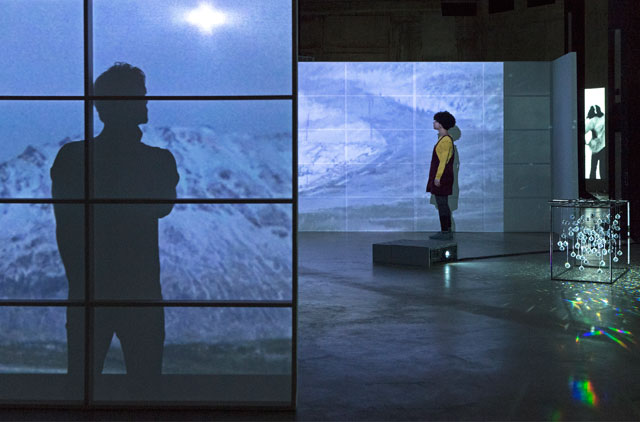
Joan Jonas, Tate Modern, installation view. © Tate Photograph: Seraphina Neville.
MKP: There were remarkable, very large shadows either side of the stage, of you with your long horn and, because the walls of the Turbine Hall are round, the shadows curved around and they were as large as the projection.
JJ: I love that space; it’s a beautiful space to perform in, and I was interested in the shadows also because the piece is about shadowing.
MKP: You said in an interview with Robert Ayres that “It interests me that people can see the performance in such different ways, they can miss one thing and see something else … one person’s interpretation and experience of it can be slightly different to the next.”6 Is this a determined stance against fixity?
JJ: No, it’s just something that I know that happens. It’s not a determined stance against fixity. I have a way of seeing my work, and I make it that way. In the videos, I’m totally in charge of the editing, the cuts, the timing, everything. When I rehearse for a performance, I sit out in front of it and I see what it looks like. I think of myself from the viewpoint of the audience, but I know that the audience is going to see something different from me and interpret it differently. So, I don’t have any control over how individuals see the work. And because there are several things going on at the same time, several people have said to me: “I saw that, but I didn’t see that.” So, I know that happens, but I can’t control that and I’m not interested in controlling that. I think we all look at things in that way [individually – seeing some things and missing some things].
MKP: You’re going back to New York tomorrow. What will you remember about your visit to London?
JJ: I’ll remember how nice it was. I’ve had a great time – everybody’s so nice here. It’s kind of a thrill to have a show like this, and then to have all these performances. It was very difficult to do all the performances, but I had a wonderful person working with me, Nefeli Skarmea, who helped organise the group performances, Mirror Piece II (1969) and Delay Delay, at low tide on the Thames. I’ve reconstructed Mirror Piece before but it was particularly wonderful to see it again here. It was wonderful to see those pieces again. Also, Mirage – I’ve done that before, but it was wonderful to see it again. My work is not really seen until it’s installed, so it’s also a very special memory for me to know that it’s existing and being shown, and when I’m back in New York I’ll concentrate on the next performance and then I’ll come back to perform it in May.
MKP: What is the next performance?
JJ: It’s something I’ve been working on for a year; I’m doing it in the Turbine Hall in May. It’s a piece about the oceans … well, that’s a very big subject – but it’s a piece about an aspect of the oceans.
References
1. See: Sounding Out: performance drawing in response to the outside environment. By M Foá, PhD dissertation, University of the Arts London. 2011, page 131. Also: Whistling Turks, bbc.co.uk/1/hi/programmes/from_our_own_correspondent/506284.stm
2. Introduction by Stephen Foster. In: Joan Jonas (published on the occasion of the exhibitions Helen in Egypt: Lines in the Sand), John Hansard Gallery, Wilkinson Gallery and Tate Modern. UK: John Hansard Gallery in association with Wilkinson Gallery, 2004.
3. tate.org.uk/whats-on/tate-modern/exhibition/bmw-tate-live-exhibition-ten-days-six-nights/joan-jonas-jason-moran
4. Draw Without Looking, 2013: tate.org.uk/research/publications/performance-at-tate/resources/films-and-videos/joan-jonas
5. What a performance Is by Tracey Warr. In: Joan Jonas 2004, op cit, page 19, Warr references Scenes and Variations: An interview with Joan Jonas by Joan Simon in Art in America, July 1995, Volume 83, Issue 7, pages 72-79 & 100-101.
6 Robert Ayres, That’s What We Do – We Retell Stories by Robert Ayres. In: Joan Jonas, op cit, page 16.
• Joan Jonas is at Tate Modern, London, until 5 August 2018, and will perform Moving Off the Land: Oceans-Sketches and Notes at the Turbine Hall, Tate Modern, on 31 May 20